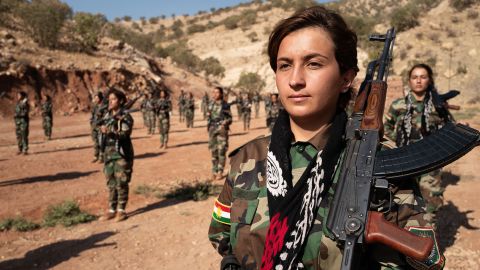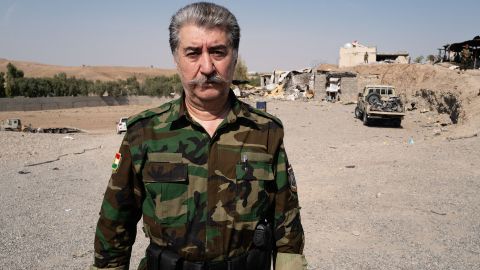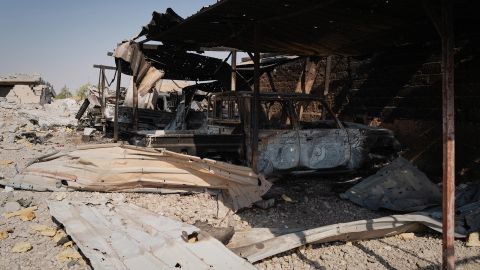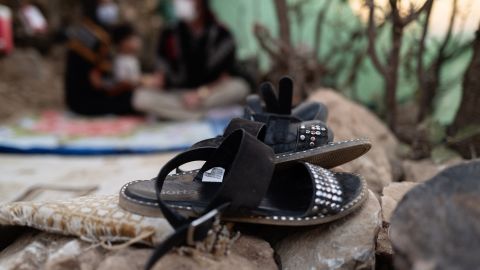Iraqi Kurdistan
CNN
—
A teenage dissident trailed behind a group of smugglers in the borderlands of western Iran. For three days, Rezan trekked a rocky mountain range and walked through minefields along a winding path forged by seasoned smugglers to circumnavigate the country’s heavily armed Revolutionary Guards. It was a trip too dangerous for respite of much more than a few stolen moments at a time.
“I knew that if an officer spotted us, we would die immediately,” said the 19-year-old Iran-Kurdish activist, whom CNN is identifying by her pseudonym Rezan for security purposes. She was traveling to the border with Iraq, one of Iran’s most militarized frontiers, where according to rights groups, many have been shot to death by Iranian security forces for crossing illegally, or for smuggling illicit goods.
She had fled her hometown of Sanandaj in western Iran where security forces were wreaking death and destruction on the protest sites. Demonstrators were arbitrarily detained, some were shot dead in front of her, she said. Many were beaten up on the streets. In the second week of the protests, security forces pulled Rezan by her uncovered hair, she said. As she was being dragged down the street, screaming in agony, she saw her friends forcefully detained and children getting beaten.
“They pulled my hair. They beat me. They dragged me,” she said, recounting the brutal crackdown in the Kurdish-majority city. “At the same time, I could see the same thing happening to many other people, including children.”
Sanandaj has seen the some of the largest protests in Iran, the biggest outside of Tehran, since the uprising began in mid-September.
Rezan said she had no choice but to take the long and perilous journey with smugglers to Iraq. Leaving Iran through the nearest official border crossing – a mere three-hour car ride away — could have led to her arrest. Staying in Sanandaj could have resulted in her death at the hands of the security forces.
“(Here) I can get my rights to live as a woman. I want to fight for the rights of women. I want to fight for human rights,” she told CNN from northern Iraq. After she arrived here earlier this month, she decided to change tack. No longer a peaceful protester, Rezan decided to take up arms, enlisting with an Iranian-Kurdish militant group that has positions in the arid valleys of Iraqi Kurdistan.

Rezan is one of multiple Iranian dissidents who fled the country in the last month, escaping the regime’s violent bid to quash demonstrations that erupted after the death of 22-year-old Kurdish-Iranian woman Mahsa “Zhina” Amini during her detention by Iranian morality police for allegedly wearing a hijab improperly.
The number of dissidents who have left Iran since the protests started is unknown. In the Kurdish-administered region of northern Iraq (KRG) — which borders the predominantly Kurdish west of Iran — many of the exiled activists keep a low profile, hiding in safe houses. They said they fear reprisals against their families back home, where mass detentions have become commonplace in Kurdish-majority areas.
According to eyewitnesses and social media videos, the people in those regions have endured some of the most heavy-handed tactics used by Iran’s security forces in their brutal campaign to crush the protest movement.
In Kurdish-majority regions, evidence of security forces indiscriminately shooting at crowds of protesters is widespread. The Iranian government also appears to have deployed members of its elite fighting force, the Revolutionary Guards, to these areas to face off with demonstrators, according to eyewitnesses and video from the protest sites.
Iran’s Revolutionary Guards typically fight the regime’s battles further afield, namely in Iraq and Syria, propping up brutal dictatorships as well as fighting extremist groups such as ISIS.

For the Kurds, the intensified crackdown in the country’s west underscores decades of well-documented ethnic marginalization by Iran’s central government. These are grievances that Iran’s other ethnic minorities share and that precede clerical rule in Iran.
The nearly 10-million strong Kurdish population is the third largest ethnic group in Iran. Governments in Tehran — including the regime of the pro-Western Shah Mohammad Reza Pahlavi who was overthrown in 1979 — have eyed the group with suspicion because of their long-standing aspirations to secede from the state and establish a republic alongside Kurdish communities in neighboring countries.
Crouched under the shade of a tree in a dusty valley alongside her sisters-in-arms in northern Iraq, Rezan clasps her AK-47 rifle, her faltering voice betraying a lingering fear of Iranian reprisals. After she fled Iran, the authorities there called her family and threatened to arrest her siblings, she said.
But her family supports her militancy, she said, with her mother vowing to bury every one of her children rather than hand them over to the authorities. “I carry a weapon because we want to show the Iranian Kurds that they have someone standing behind them,” Rezan said from one of the bases of her militant group, the Kurdistan Freedom Party (PAK). “I want to protect the Kurds there because the Kurds are protecting themselves with rocks.”
Protesters across Iran are largely unarmed. Yet Iran blames Kurdish-Iranian armed groups in Iraqi Kurdistan for instigating unrest in Kurdish-majority areas. It has repeatedly struck Iranian-Kurdish targets in Iraq with drones and missiles since the protests began, killing scores of people.

Last Saturday, Iran’s Armed Forces chief accused the Iraqi Kurdistan region – which has a semi-autonomous government – of harboring 3,000 Iranian-Kurdish militants, and vowed to continue to attack their bases unless the government disarms the fighters.
“Iran’s operations against terrorists will continue. No matter how long it takes, we will continue this operation and a bigger one,” said Maj. Gen. Mohammad Hossein Bagheri, the chief of staff of Iran’s Armed Forces.
PAK and other Iraq-based Kurdish-Iranian armed groups say they have not supported the protests in any concrete way. But they have called on the United States to intervene on behalf of the demonstrators, and have said they are prepared to help Kurds in Iran take up arms in case of a further escalation in Iran’s crisis.
“What’s happening on the streets with the protesters was not engineered at my base,” PAK’s leader, Gen. Hussein Yazdanpanah, told CNN. He was speaking from one of the group’s barracks that was blown up by Iranian missiles and drones on September 28, killing eight militants.

“(Iran) is using us as a scapegoat for the protests in Iran and to distract media attention from Iran,” said Yazdanpanah, who believes that he was the target of that attack.
“I won’t hide the fact that I am a military support for my people,” he said, standing amid the destruction at his base near the town of Altun Kupri. The stench of two militants slain in the attack, but whose bodies have not yet been recovered, rises up from the rubble.
“For a revolution to succeed there has to be military support for the people,” he added. “(Iran) wanted people to question this principle. (By bombing the base) they wanted to say to them that there is no military support to protect you.”
Across the country, protesters with a variety of grievances — namely related to the dire state of Iran’s economy and the marginalization of ethnic groups — have coalesced around an anti-regime movement that was ignited by Amini’s death. Women have been at the forefront of the protests, arguing that Amini’s demise at the hands of the notorious morality police highlights women’s plight under Islamic Republic laws that restrict their dress and behavior.
Kurds in Iran also saw their grievances reflected in Amini’s death. The young woman’s Kurdish name — Zhina — was banned by a clerical establishment that bars ethnic minority names, ostensibly to prevent sowing ethnic divisions in the country. Amini also was crying for help in her Kurdish mother tongue when morality police officers violently forced her into a van, according to activists.

The first large protests in Iran’s current uprising erupted in Amini’s Kurdish-majority hometown of Saqqez in western Iran, which has also been subjected to a violent crackdown. “When we were in Iran, I joined the protests with friends. Two days later, two of my friends got kidnapped and one of them got injured,” said one man who fled Saqqez to Iraqi Kurdistan, who CNN is not naming for security reasons.
Seated on carpet under a tree to avoid any identification of their safe house, the man and his family said they worry about the long arms of Iran’s regime. The family cover their faces with medical masks, the man wears long sleeves to cover identifying tattoos and a plastic tarp is hung up to obscure them from the ever-present fear of incoming Iranian drones.
He and his family decided to leave Iran when he saw security forces kill his friend near a mosque in the first days of the uprising, the man said. “How can they claim to be an Islamic Republic when I saw them murdering my friend outside a mosque?” he asked in disbelief.

He said the community could not retrieve his friend’s body until night fell, after which they secretly buried their dead. His testimony is similar to multiple accounts CNN has heard since the start of Iran’s uprising. Many in the Kurdish areas of Iran report opting not to receive medical care for injured protesters in hospitals, for fear of arrest by authorities. Eyewitnesses also say some have even avoided sending their dead to morgues, for fear of reprisals against family members.
Since they fled, dissidents in Iraqi Kurdistan say they remain in contact with the loved ones they left behind. Every phone call to their families comes with news of an intensified crackdown, as well as reports of people defying security forces and continuing to pour into the streets.
“From what I know, my family is part of the revolution and the revolution continues to this day,” said Rezan. “They are ready to die to get our rights.”